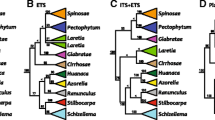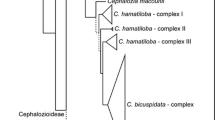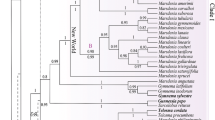Abstract
The polyphyly ofSarcostemma sensu latu, suspected on morphological and karyological reasons is confirmed by analysis of thetrnL-F spacer region. With the exception ofCynanchum montevidense (subgen.Mellichampia, Sundell 1981), Old World and New World taxa belong to different clades.Sarcostemma sensu stricto andPlatykeleba show a strong affinity to Old WorldCynanchum; the affinities ofOxystelma cannot be determined at present.Philibertia andBlepharodon are sister groups, both are sister toFunastrum, andPentacyphus is basal to the New World clade.
Similar content being viewed by others
References
Albers F., Liede S., Meve U. (1993) Deviating chromosome numbers in Asclepiadaceae. Nordic J. Bot. 13: 37–39.
Albers F., Meve U. (2000) A karyological survey of Asclepiadoideae, Periplocoideae and Secamonoideae, and evolutionary trends in Apocynaceae s.l. Ann. Missouri Bot. Gard. (in press).
Bremer K. (1988) The limits of amino acid sequence data in angiosperm phylogenetic reconstruction. Evolution 42: 795–803.
Bullock A. A. (1956) Notes on African Asclepiadaceae VIII. Kew Bull. 11: 503–507.
Descoings B. (1961) Notes taxonomiques et descriptives sur quelques Asclépiadées cynanchées L. (Asclépiadacées) aphylles de Madagascar. Adansonia, sér. 2.1: 299–342.
Doyle J. J., Doyle J. L. (1987) A rapid DNA isolation procedure for small quantities of fresh leaf tissue. Phytochem. Bull. 19: 11–15.
Holm R. W. (1950) The American species ofSarcostemma R.Br. (Asclepiadaceae). Ann. Missouri Bot. Gard. 37: 477–560.
Liede S. (1996)Sarcostemma (Asclepiadaceae) — a controversial generic circumscription reconsidered: Morphological evidence. Syst. Bot. 21: 31–44.
Liede S. (1997) Subtribes and genera of the tribe Asclepiadeae (Apocynaceae — Asclepiadoideae) — a synopsis. Taxon 46: 233–247.
Liede S., Meve U., Mahlberg P. G. (1993) On the position of the genusKarimbolea Descoings. Amer. J. Bot. 80: 215–221.
Morillo G. N. (1976) A revision ofBlepharodon (Asclepiadaceae). M.Sc. thesis, St. Louis, Missouri, St. Louis University.
Schlechter R. (1914)Philibertia H. B. et Kth. undFunastrum Fourn. Feddes Repert. Spec. Nov. Regni Veg. 13: 279–287.
Sundell E. (1981) The New World species ofCynanchum subgenusMellichampia (Asclepiadaceae). Evolutionary Monographs 5: 1–62.
Taberlet P., Gielly L., Pautou G., Bouvet J. (1991) Universal primers for amplification of three non-coding regions of chloroplast DNA. Plant Mol. Biol. 17: 1105–1109.
Author information
Authors and Affiliations
Rights and permissions
About this article
Cite this article
Liede, S., Täuber, A. Sarcostemma R.Br. (Apocynaceae — Asclepiadoideae) — a controversial generic circumscription reconsidered: Evidence fromtrnL-F spacers. Pl Syst Evol 225, 133–140 (2000). https://doi.org/10.1007/BF00985463
Received:
Accepted:
Issue Date:
DOI: https://doi.org/10.1007/BF00985463




